
Topics
Isolated and marginalized in normal times, today we look at the plight of Native Americans in the deep bayous of Louisiana in the aftermath of Hurricanes Katrina and Rita. [includes rush transcript]
Aid has been slow in reaching these communities and tribal members are still awaiting much-needed supplies from FEMA. There is evidence the tribes have suffered disproportionately from the devastation of the hurricanes because they have been overlooked by federal agencies and relief organizations.
Tribal members say relief efforts have been hindered because they do not have federal recognition as Native American tribes. The communities have state recognition but have been struggling for federal recognition for decades.
One tribal chief says FEMA was very slow because it didn’t even know the tribes existed.
Tribal members also say a general lack of media coverage has kept the public in the dark about the communites’ plight.
Independent filmmaker Gregory Berger recently spoke with tribal leaders of the Biloxi Chitimacha tribes in southern Louisiana. He filed this report.
- Native American communities continue to struggle in the Bayous of Louisiana
Transcript
AMY GOODMAN: Independent filmmaker Gregory Berger recently spoke with tribal leaders of the Biloxi-Chitimacha tribes in Southern Louisiana. He files this report.
GREGORY BERGER: These are the bayous of Southern Louisiana. If you’re not from here, then you probably don’t know that it is home to more than 20,000 Native Americans.
CHIEF RANDY VERDUN: Alright, the Isle de Jean Charles Band of Biloxi-Chitimachas community, most of this area of underwater during — right after Hurricane Rita came through.
GREGORY BERGER: Chief Randy Verdun of the Bayou Lafourche Band of Biloxi-Chitimacha.
CHIEF RANDY VERDUN: Our community, Bayou Lafourche Band of Biloxi-Chitimachas, they came in the mid to late 1800s, and it was my grandmother’s grandfather who was the first one here.
CHIEF ALBERT NAQUIN: The Island started back in around, I guess, 1835, 1840, maybe.
GREGORY BERGER: Chief Albert Naquin of the Isle de Jean Charles Band of Biloxi-Chitimacha.
CHAIRWOMAN MARLENE FORET: I was born in 1946, same year as Albert. We were born Dulac. I was born at home with a midwife.
GREGORY BERGER: Chairwoman Marlene Foret of the Grand Caillou/Dulac Band of the Biloxi-Chitimacha.
CHAIRWOMAN MARLENE FORET: My parents, my dad was a fisherman, a trapper, and like Albert, you know, did all the gardening and fishing. We lived off the waters and the land because gardening and fishing.
CHIEF ALBERT NAQUIN: And with that, that there was some trading going on. I mean, it’s not everybody that would raise the same thing, so some people would raise certain things in their garden, and it was just like the fishing part, also. My dad fished a special trout, and he’d catch shrimps and oysters, but then there were some others that would go crabbing and do other things, so we’d swap fish for crabs and what have you.
GREGORY BERGER: In the aftermath of Hurricanes Katrina and Rita, both of which affected the area, the media paid almost no attention to the problems facing Indian communities in Coastal Louisiana.
CHIEF RANDY VERDUN: You may see it in the local newspapers or local news media. The only way you’ll really find out information is if you maybe do a search on the internet. I’m not sure why that is, but that’s just the way it played out this time, and I think, for the most part, it’s the way it’s been for a long time. You know, you just don’t see the plight of the poor people in these Indian communities. You just don’t see it.
GREGORY BERGER: But it wasn’t just the media that ignored these communities.
CHIEF ALBERT NAQUIN: FEMA hadn’t even heard that there were some communities past Houma, I believe it was, so they didn’t know anything about Native Americans in the lower bayous. All they knew was the little maps that they would see with the highways, but in the maps that they have, our community don’t even show — exist on there. So, yeah, FEMA actually admitted that they didn’t know that it had Indians, people living in the lower bayous.
CHAIRWOMAN MARLENE FORET: I haven’t seen anything from the federal or state. FEMA, I don’t think anybody has heard from FEMA since this storm, unless they went on the internet.
GREGORY BERGER: Native American communities in the bayous were left to fend for themselves. Yet FEMA’s failure to respond was only the latest incident in a history filled with neglect and abuse of Native American communities.
CHIEF RANDY VERDUN: As time went on in the, I guess, the 1940s, when the oil boom came, a lot of the land started changing hands, and some of that was done, I think, maybe in some ways underhandedly. We have some stories that a lot of the land was supposedly leased to oil companies and, in fact, a lot of these people were signing bills of sale and, I think, even forgery.
CHAIRWOMAN MARLENE FORET: We were living on my grandfather’s property, and grandpa was the owner until grandma got sick, and then he had to kind of go to the grocery store and buy groceries and put the land up for collateral and eventually was unable to repay, and the land got taken from him. I don’t think he was even offered to pay, because I don’t think he ever saw a bill for the property.
CHIEF RANDY VERDUN: I think what made it easy, I think what made Indian people easy targets, first few of them were educated. At best in my father’s generation, at best they had a seventh grade education. In my grandparents’ generation, they had no education, so they couldn’t read and they couldn’t write. Even if they wanted to take some type of action to stop those things that were happening to them, that was happening all around them, they weren’t able to.
GREGORY BERGER: Compounding the challenges Indians faced to try to hold onto their land, they soon faced a new threat: The land itself began to disappear.
CHIEF RANDY VERDUN: You know, what basically caused us to be more vulnerable, then, especially in light of these hurricanes, when the oil field came in, they started drilling, and they started digging their canals to bring their drilling equipment. Those canals were dug specifically for the drilling equipment, so they dug it. It was, you know, just sufficient size to get the equipment in and out, but those things were left once the drilling was completed, but those canals were left open. And you can look at some of the area photographs from 1940 all the way to the present, and what started out to be a canal maybe, you know, 60-80 feet wide is now, you know, several hundred yards wide. And it’s just opened up the salt water to come in and just eat away the marsh like a cancer. And you’re just losing — and they talk about it all the time, losing football fields a day.
CHAIRWOMAN MARLENE FORET: Their community is more vulnerable now than it was way back. Oil companies came in and drilled for gas, oil, and the canals, in many of them — and the water kept coming in and salt water, and it just killed the vegetation there, and then as the water was coming in, then the land could not replenish itself.
CHIEF ALBERT NAQUIN: And also the pipelines. Say, like, we have like seven pipelines. So to lay the pipeline, they also dig a canal. What it does, it takes the land, and water takes over. Water fills up that deal, and then water comes in a lot faster, like now. Like from when I was a little kid, you’re looking at between high tide and low tide, you’re looking about, oh, I guess maybe six maybe to ten inches depending, I guess, on which way the wind was coming from, and now you’re looking at probably two feet an hour with a stronger south wind. So, like, see, all of our oak trees are dying, and I guess five-ten years, depending on how much salt water we get, I mean, all the trees on our land probably are going to be all dead.
CHAIRWOMAN MARLENE FORET: And it’s going to keep on going further up from the way it looks today with the two hurricanes here.
GREGORY BERGER: After generations of being gradually pushed out into the bayous and with the land now literally disappearing from under their feet, it was inevitable that Hurricanes Katrina and Rita would disproportionately affect Native American communities.
CHIEF ALBERT NAQUIN: Katrina wasn’t too bad. We had wind damage. We had five homes that needed major roof repair. But then Rita came around with the water.
CHAIRWOMAN MARLENE FORET: A majority of big — I’d say 80% of the homes in the community went underwater, not totally under, but, I mean, they had several feet of water in the homes.
CHIEF RANDY VERDUN: As the water came up, it left a lot of the dirt, once the water receded. You can see it on the roads, you can see it in the homes itself. If you walk into the homes, you might have an inch to three inches of dirt, which all has to be cleaned out. People will start to clean up. You see a lot of the debris, household items, mattresses, appliances, all outside now. Those things are no longer useful.
GREGORY BERGER: So what do Indian communities propose to do about it? Above all, they wish to be heard.
CHIEF RANDY VERDUN: I think there’s a breakdown in communication, because if they didn’t know we existed, how can they serve you?
CHIEF ALBERT NAQUIN: The people in the community can solve the problem better, because they know what’s going on. I mean, they’re there every day. The Red Cross and FEMA, they come and say, 'What can we do to help? I mean, how can we help?' And we could give them the answer on how to help us, better than them sitting over there saying, 'Well, let's do this for these people. Let’s do that for these people.’ Sometimes we don’t need that. I mean, we need something else.
GREGORY BERGER: Many Indian people also want a comprehensive levee system that might protect them from future storms.
CHAIRWOMAN MARLENE FORET: A Well, they would have to have the levee, the Morganza to the Gulf, as they’re calling it. And we — people are just going to have to try to get behind — not behind, push the federal government into giving money so that these levees can be built to protect it.
CHIEF ALBERT NAQUIN: But, you know, ain’t nobody want to listen to me, so I guess I’m going to have to go there with my sack of cement and build it myself.
GREGORY BERGER: But in the uphill battle to protect themselves from future hurricanes in the Gulf, one key political obstacle stands in the way of the Indian people of the Louisiana Gulf Coast: Federal recognition. As of yet, the Bureau of Indian Affairs has yet to grant any of the Indian tribes of the region federal recognition status.
CHIEF RANDY VERDUN: Being federally recognized, you basically become an entity of and by itself, which is basically on the same playing field as a state. If you’re federally recognized, then you have access to federal funds. You have — you probably have a lot less bureaucracy. You have a direct connection with the federal government, because you are — you know, you go straight to the B.I.A., and the B.I.A., of and by itself, is its own agency, so you don’t have all the red tape, and I think you have a direct connection to federal relief efforts.
CHAIRWOMAN MARLENE FORET: And I really believe if they would have the protection, people would move back to their community, move back into the Lower Dulac and Grand Caillou area.
NATIVE AMERICAN WOMAN: I am proud to be an Indian. The government, they want to buy out the people on the bayou. And, I mean, you know, they don’t have enough money in the world to buy out these people, because the people love the bayou. Bush better have a lot of money to put us back in — you know, back — restore us back, because he’s not going to stop us. He’s not going to stop us.
GREGORY BERGER: For Democracy Now!, this is Greg Berger, reporting from Southern Louisiana.
AMY GOODMAN: This is Democracy Now!, DemocracyNow.org, the War and Peace Report. And to see the video and photographs, the images of the deep bayous of Louisiana, you can go to our website and watch the video podcast or listen to the audio podcast.

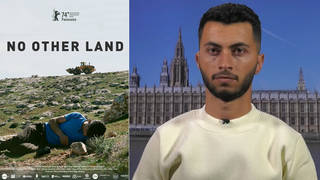
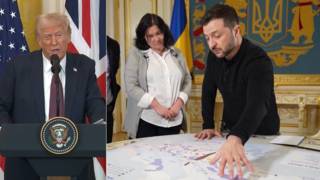
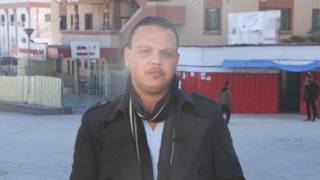

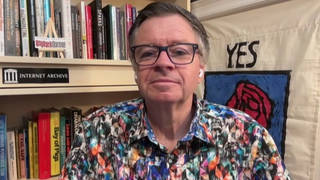
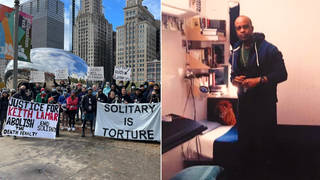

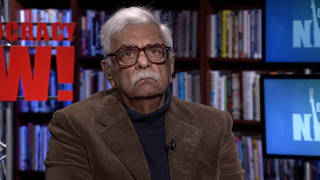

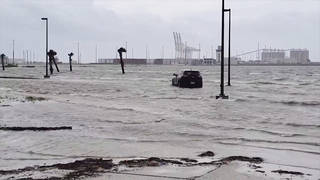

Media Options